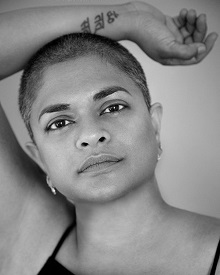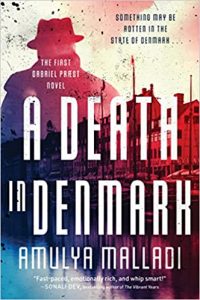Feeling Fraudulent: A Brown Woman Writes From a White Man’s Point of View
Feeling Fraudulent: A Brown Woman Writes From a White Man’s Point of View
 I’m a big fan of Raymond Chandler’s Philip Marlowe, Robert B. Parker’s Spenser, Sara Paretsky’s V.I. Warshawski, Kerry Greenwood’s Phryne Fisher and others. I’m also a big fan of Copenhagen, my adopted city where I lived for eleven years. So, I knew that if I ever wrote a mystery, it would be set in Copenhagen. And for some unknown reason, I had decided that my Private Investigator would be a man. A white man.
I’m a big fan of Raymond Chandler’s Philip Marlowe, Robert B. Parker’s Spenser, Sara Paretsky’s V.I. Warshawski, Kerry Greenwood’s Phryne Fisher and others. I’m also a big fan of Copenhagen, my adopted city where I lived for eleven years. So, I knew that if I ever wrote a mystery, it would be set in Copenhagen. And for some unknown reason, I had decided that my Private Investigator would be a man. A white man.
Full disclosure, I’m a brown woman, born and raised in India who has lived in Denmark and the United States for 28 of my 48 years, so more than half my life. All I know about white men intimately is what I have learnt from my husband, the whitest of all white men, a middle-aged Scandinavian.
For the past decade, every time I was between books, I would try my hand at what I used to call my Copenhagen PI story. I knew several things about my PI. He was bald. He was in his early forties. He was single. He had a daughter who was grown up. She was close to him and her mother and bonus father (that’s what they call stepparents in Denmark). He liked good food and wine. He rode a bicycle and didn’t own a car. He lived in one of the townhouses in the center of the Copenhagen by the lakes. He was not an alcoholic. He didn’t carry any childhood trauma.
I wanted my PI to be self-aware and a snappy dresser; unlike the detectives and investigators in most Nordic Noir who’re lousy dressers (think Inspector Sarah Lund in The Killing who wore horrible sweaters that for some strange reason became popular); or were alcoholics (think Jo Nesbø’s Harry Hole), or was on the spectrum (think Saga Norén in The Bridge)—all books and shows I love, but I wanted my PI to be more like the people I knew in Copenhagen.
The tricky part was writing him.
I started writing in third person to feel less dishonest, because if I wrote in first person, a brown woman writing a white man, I’d feel like a fraud. As I started to write, I kept sliding into first person no matter how hard I tried. I finally gave up and decided I’d write in first person, because for some reason my brain wasn’t registering that I wasn’t a white man.
His name came to me slowly and one day my Copenhagen PI became Gabriel Præst.
As part of my writing process, I read out what I write as soon as I write it to my husband to make sure it’s not complete drivel or my character is not suddenly doing something they would never do or that it’s in mostly English. Every time I’d finish reading parts of A Death in Denmark, he’d give me his feedback and then I’d ask, “Does he sound like a white dude?” And every time my husband would say to my frustration, “Why wouldn’t he?” And I’d answer, “Because I’m brown.”
My husband’s logic was that if men could write from a woman’s perspective, which they’d been doing for years, then I, as a woman who worked in a man’s world and lived with three men (my husband and my sons) had absolute authority to write Gabriel.
Of all the books I have ever written, this one gave me the most self-doubt and sleepless nights. When I was finally done with all the edits, I tentatively told my agent I’d written a Private Investigator mystery and she, to her credit, didn’t laugh but said, “Sure, I’ll read it.”
I had never written a mystery before and here I was writing it from a man’s perspective. My agent had never sold a mystery before.
In the end, she knew how to sell my book better than I knew how to write it. For the first time in my writing career, I had offers from two publishers. If I’d known that writing from a white man’s perspective would get me this kind of attention, I’d have girded my loins and done it earlier.
But I know now that I had to write eight books with female protagonists to reach this place where I had the confidence to tell a story with a man’s voice. Writing is a journey and if we do it well, the destination is a book contract and readers who love the book.
—
Amulya Malladi is the bestselling author of eight novels, including The Copenhagen Affair, A House for Happy Mothers, and The Mango Season. Her books have been translated into several languages, including Dutch, French, German, Spanish, Danish, Romanian, Serbian, and Tamil. She won a screenwriting award for her work on Ø (Island), a Danish series that aired on Amazon Prime Global and Studio Canal+. Currently living in California, she is a Danish citizen who was born and raised in India.
A DEATH IN DENMARK
Category: Contemporary Women Writers, How To and Tips

 Meet Gabriel Præst, an ex-Copenhagen cop (who dresses with panache), jazz aficionado, and relentless pursuer of truth as he explores Denmark’s Nazi-collaborator past and anti-Muslim present in a page-turning Nordic murder mystery with a cosmopolitan vibe
Meet Gabriel Præst, an ex-Copenhagen cop (who dresses with panache), jazz aficionado, and relentless pursuer of truth as he explores Denmark’s Nazi-collaborator past and anti-Muslim present in a page-turning Nordic murder mystery with a cosmopolitan vibe























